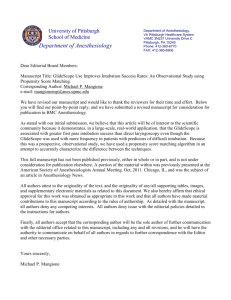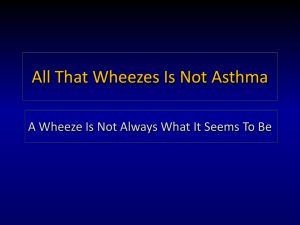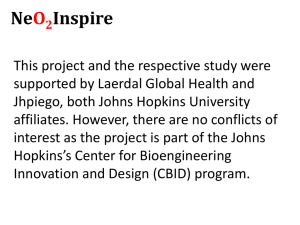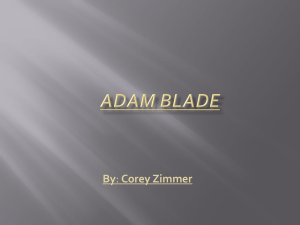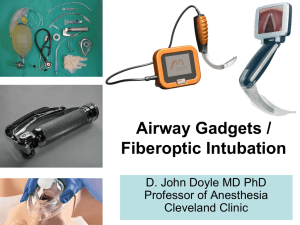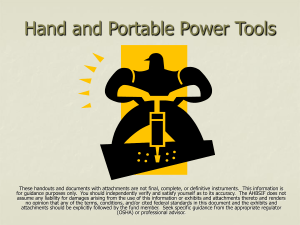Journal Club Presentation
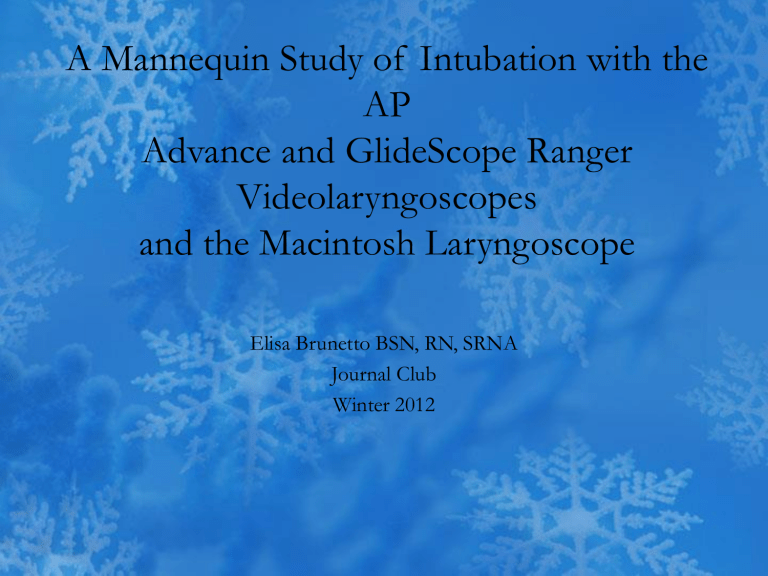
A Mannequin Study of Intubation with the
AP
Advance and GlideScope Ranger
Videolaryngoscopes and the Macintosh Laryngoscope
Elisa Brunetto BSN, RN, SRNA
Journal Club
Winter 2012
Brewer, E.J., Cata, J., Dalton, J.E., Doyle, D.J., Hodd, J.A., James, M.
& Sessler, D.I. (2011). A mannequin study of intubation with the AP Advance and GlideScope Ranger Videolaryngoscopes and the Macintosh Laryngoscope. AANA, 111(13), 791-800.
Introduction
• October 2011 AANA journal
• Conducted at Cleveland Clinic
• IRB approved
• Clinicians who “might” intubate during their clinical practice were eligible
– Group 1: medical students and clinicians with little to no experience
– Group 2: Paramedical and medical staff with experience using MAC blades
– Group 3: anesthesia provides with GlideScope and MAC blade experience
Purpose
• Assess if the AP Advance (APA) takes the same amount of time as a MAC blade to intubate normal airways and a GlideScope with difficult airways on a mannequin
Background
• AP advance
– Videolaryngoscope
– Has interchangeable blades (Traditional MAC blade or difficult airway blade with increased curvature and channel to guide tube into the airway)
Background
• MAC Blade
– Chosen because it is ubiquitous and highly effective in normal airways
– First blade chosen for beginners
• Glidescope
– Selected for its proved efficacy and ease of use over other alternative airway techniques
Study
• Each participate received the manufactures instructions for the device as well as a demo
• Participants were then allowed to practice each device on a normal airway mannequin
Study
• Envelope blinded participates to scope and airway order until the start of the study
• Timing started when participate first touched airway equipment
Study
• Failed airway
– Unrecognized esophageal intubations
– Abandoned procedures
– Intubations that took greater then 120 sec
– Intubations that required more then 3 attempts
Study
• Failed attempt
– Removal of airway equipment without successful intubation
– Number of attempts and failed intubations was recorded
Study
• Potential damage
– Assessed by comparing number of misdirected advances of the ET tube
• Ease of glottic view
– Measured by recording time required by participants to say they had the best view
– Time required to place tube after view obtained was recorded
Study
• Participants
– Asked to recommend device for use in normal airway, difficult airway, single device for all intubations
– Rate GlideScope and AP Advance on portability, light source, picture quality, and position of screen
Statistical Analysis
• Stratified Cox regression model was used for each airway
– Based on adjusted categories on participants experience
– Enrolled 90 participants which was 50% more then previous studies using the AP Advance
– Significance at >0.8
Results
• Normal airway mannequin
– Intubation times were longer with GlideScope then other two devices
– Intubation time for AP advance was 22 sec and 23 sec for the glideScope
– AP advance had one failure, GlideScope 5, MAC blade 3
– AP advance 7 times more likely to have a better view more quickly
Results
• Difficult airway
– AP Advance required least time followed but
GlideScope and finally MAC blade
– 20 sec for AP advance vs 59 sec GlideScope
– AP advance had no failures, GlideScope 30 (33%),
MAC blade 33 (37%)
Results
• AP Advance caused less damage to glottis
• 82% of users would chose the AP Advance if they had only one device for use
• Preferred screen position and portability
Strengths
• Mannequin used provided that the same airway was used for each device and practitioner
• Device that was to be used was blinded to participants
• Participants all received an opportunity to practice with the device before using in the study
Weakness
• Mannequins fail to have the same texture of human tissues
• Didn’t take into account cost for devices
– GlideScope 11,000, $15 per blade
– AP Advance 7500, $45 per blade
• To many different skill levels were used
– Could have contributed to the high number of failed intubations due to the novice skill set
Implications to Practice
• Use the AP Advance when available at facilities
• Encourage facilities to purchase AP Advance if budgeting allows


